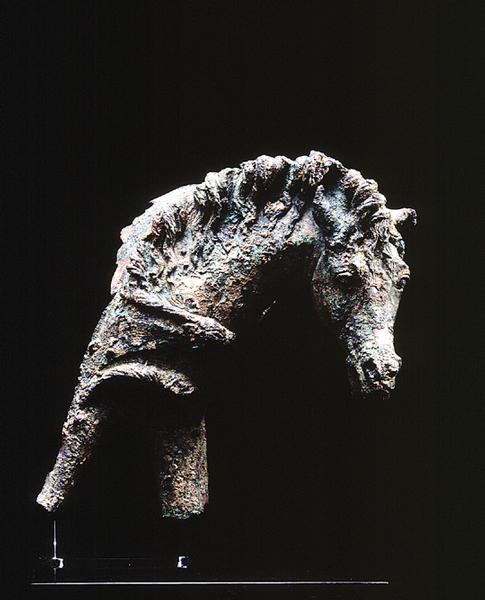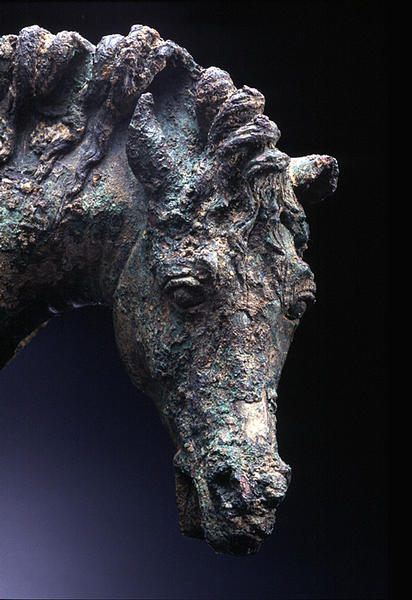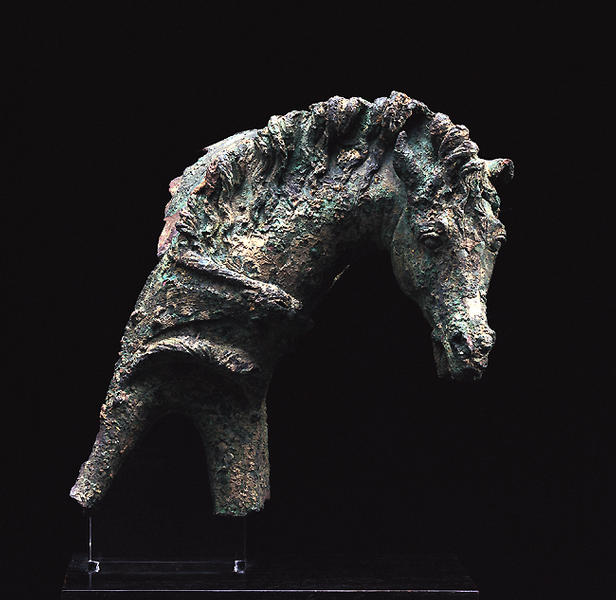馬形の飾り
- ギリシア
- 紀元前2-紀元前1世紀
- 青銅
- H-20 D-16 W-8.2
Catalogue Entry
This bronze horse head once decorated the fulcrum, or armrest, of a kline, a luxurious banqueting couch. At a symposium in someone's private home, where men gathered to enjoy fine food, conversation, and other entertainments, a series of such couches were arranged around the center of the room for easy interaction. Added pillows and bolsters made the kline quite comfortable. Usually the kline had a fulcrum on the left side so that a right-handed, reclining banqueter could lean on his left arm, leaving his right hand free for eating and drinking.1
Bronze fulcrum decorations came into fashion by the later second century B.C., and are represented among the finds of the Mahdia shipwreck that date to 100 B.C.2 They continued in use at least through the second century A.D. Subjects include horses, mules, mastiffs, ducks or geese, panthers, lions, and elephants, with members of the equine family being most prevalent. There are at least three examples close in style to the Shumei horse head, all dated to the later second and early first centuries B.C.3
Mules were sacred to the god of wine, Dionysos, and outnumber horses in this type of object, but the Shumei beast is a horse. His intact right ear is relatively small and delicate; a mule's would be twice the size. His long, ropy mane is that of a horse, albeit a very unkempt one; mules have naturally short, scruffy manes.
The Shumei horse's jaw is slack and his eyes unfocused. His ears, which flop in different directions, show anything but alertness. A horse, like a mule, can easily drink three gallons of liquid at one time, and this creature seems to have consumed his entirely in wine. Around the neck is what remains of a panther skin, suggesting that the beast did his drinking in the company of Dionysos, whose followers often wore this garment.
APK
1. For an example of a bed with two fulcra and an excellent discussion and bibliography of the type see Reeder 1988, pp. 159-61, no. 68, dated 100-50 B.C. These attachments have been studied by Sabina Faust; see Faust 1989.
2. Fuchs 1963, pp. 11-12.
3. Barr-Sharrar 1987, pl. 16, no. C51; pl. 19, no. C57; pl. 20, no. C59, 2.
解説(古代バクトリア遺宝展)
前2―前1世紀
青銅
高20.0 cm 幅8.2 cm 奥行16.0 cm
この馬の前半身は、ギリシャの寝椅子に装飾としてつけられていたものと考えられる。アッシリアの宮殿浮彫に見られるように、西アジアでは王の特権であった寝椅子での酒宴は、ギリシャでは貴族の気取った風習となった。シンポシュオンと呼ばれるこの酒宴に参加する者は花綱の冠をかぶり、献酒と祈りで始まり、この寝椅子でくつろぎながら哲学談義や娯楽を楽しんだ。通常は椅子のせりあがったクッションにもたれ、右が利き腕である場合、左腕で上体をおこして右腕で酒盃を傾けたのであるが、その椅子のせりあがった部分の前面には、ひきのばされたS字形の飾りが取り付けられ、その上部にしばしばこのような馬や驢馬の頭部などがあしらわれた装飾が施されていた。
本作品は鬣が乱れ、眼はうつろで耳は左右とも違った方向を向いている。これはおそらく酩酊風の馬を作り出しており、ディオニュソスの従者がしばしばまとう豹の毛皮をこの馬がまとっていることからも、この意匠が酒神ディオニュソスに関連づけられていることがわかる。
Catalogue Entry(Bac#024)
2nd-1st century B.C.
Bronze
H. 20.0 cm, W. 8.2 cm, Depth 16.0 cm
This horse forequarters is thought to have originally been used as an ornament on a Greek banqueting couch. Relief carvings in the Assyrian palace show that in the western Asia the king had the special privilege of being seated on a banqueting couch at banquets, and this was a favorite custom amongst the Greek aristocracy. This banquet event was known as symposium, and those who attended these banquets would be adorned with floral crowns, would begin the event with libation wine and prayers, and then would lie back on these couches as they enjoyed philosophical discussions and other pastimes. Normally guests would recline on cushions on these couches and if the guest was right handed, they would lean on their left arm and use their right hand for drinking. The raised backs of these couches would have an extended S-shaped decoration, and frequently the top of this S-shape would be fitted with a horse or other animal head.
The mane of this horse is disheveled, the eyes bulging and the ears facing in different directions. This would appear to be a depiction of a drunken horse, and given that the followers of Dionysus would often drape such horses with a panther skin, we can see that this motif was linked to the god of wine, Dionysus.


